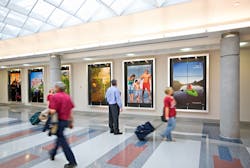Grasping Attention of the Present Day Passenger in an Airport
Airports market themselves first and foremost. They’re representatives of the community and want the community to take advantage of what the airport has to offer.
Scott Elmore, vice president of marketing communications for the Airport Council International North America (ACI-NA), said they see airports take comprehensive and ambitions campaigns that are interesting and fun to watch. The marketing industry is striking, because of how dynamic and complex the level of research that goes into developing a campaign for an airport.
“There is a new trend happening where there is an idea of a signature drink at an airport. CVG just launched a new beer. Tampa now has the spirit of flight. They had all their concessionaires, bartenders, mixologists come together to create this,” Elmore said. “Wherever you are at in the Tampa airport you can access this new beverage.”
It gives airports an opportunity to promote what they have to offer, Elmore said. As well as show the relationship between the concessionaire and the airport.
The target audience of the campaigns vary greatly from airport to airport.
“They do a lot of work at different levels trying to engage every passenger at every level of the journey,” Elmore said. “Whether you are booking on your smart phone or buying online. They figured all that information out and are really good at how they identify and target their audience.”
Marketing and Advertising with Modern-Day Technology
Henry Blechman, director of national sales, Boingo Media has a filtered strategy to target their audience and unite different audiences in a captive way while sponsoring free Wi-Fi to travelers.
Boingo Media works with brands to market to consumers and impact the common media through a free filtered platform that travelers want by helping airport partners monetize their wireless network and bring empowerment to the audience.
“It’s important for brands to keep customer satisfaction in mind especially when thinking about Wi-Fi platforms. Media and advertising should help serve the end user other than just simply promote,” Blechman said. “For example, digital ads with common channels are often riddle with issues like too many ads too much clutter, some other ads are not always seen and sometimes adds can be downright annoying.”
When thinking about the audience Blechman said he likes to categorize them into three specific groups: business travelers, high-end travels and millennials.
Boingo Media works with brands or agencies to try to come up with a custom message for business travelers who are decision makers that need to stay connected to work wherever they are.
Blechman suggested, “Those B2B brands might say ‘Enjoy free Wi-Fi brought to you by this brand the sponsor to help get work done.’”
New to market in the past few months is destination targeting Blechman said. Brands can target consumers based on flight destination, tracking API and mapping technology. Brands can even target travelers down to a specific destination based on the gate that they are sitting at.
For those business travelers Blechman said, “A B2B brand might be looking to advertise on the way to a conference and you can put a message in front of those specific travelers.”
When thinking about high-end travelers, hard to reach leisure travelers, with a lot of dwell time between flights Blechman said, “With the destination targeting you can target travelers within a terminal and say check out this business or service that might be right around the corner from you within the same terminal,” Blechman said. “That’s driving awareness and foot traffic.”
Airports can also showcase upcoming amenities or services, or current ones within the venue and can show it on the user’s device.
Reaching out to the millennials is tricky. Blechman said, they’re inundated with media options, apps and advertising.
“Let’s say you have a tech brand looking to show an app that they’re looking to drive users to. The call to action could be for them to download the app,” Blechman said. “An entertainment brand is looking to break through and they’re going to say, ‘enjoy free Wi-Fi brought to you by this streaming platform and check out this episode or series before or during your flight if you can download it before your flight,’ that’s a common message for those entertainment brands.”
Besides the platform being a great revenue stream for airports it is also an import messaging platform that is free of clutter and tailor focused to the individual user.
Advertising By Utilizing Space in an Airport
Airports are an economic generator for a local community. Elmore said they often think of airports as the first impression a person has of a community or the last experience a community has upon their departure. Making sure that both the arrivals and departures really reflect that local flare is incredibly important.
“Tampa International Airport has just re-done their entire concessions program. They are also in the middle of a capital improvement project. They’ve brought in new concessions offerings, lots of local flavors and flare. They are increasing their international service,” Elmore said.
Leslie Bensen, CEO Departure Media Advertising, helps airports reach local, national and international audiences with its techniques in advertising. The company creates displays that are distinctive to each airport’s aesthetics and introspective of the town or city the airport is in distinguishing a feeling of local flare.
“We have a Honda engine display in our Dayton, Ohio airport, because they make those there,” Leslie Bensen said, CEO of Departure Media Advertising. “The program we run is really reflective and creates a sense of place and a source of pride in airport marketing.”
Bensen is involved with creative enhancements to make airport displays represent a specific area but also grab the attention of every spectator.
“We don’t buy cookie-cutter signs and hang them on the wall. We go the next step. We have more architectural features than just an advertisement,” Bensen said. “We are brokers of the space in airports and do a lot of design work with the cases and displays that we create.”
Airports do a lot of local community engagement.
“A lot of times engagement will happen around things that need conversation in the community,” Elmore said. “Flight patterns that reach different level of noise. Capital improvements and construction that comes along with maintaining an airport.”
Passengers come to expect a higher level of service when traveling. There is a demand for local food, local retail and demand for connivance.
“We monitor a lot of what airports are doing in their marketing. We see some really creative approaches and dynamic campaigns that they have developed over the years to help position their airport within their community. To help attract and retain air service. Promote their concessions and work on their parking efforts,” Elmore said.
About the Author
Eavan McGrath
Assistant Editor
Eavan McGrath originates from northern Illinois and is a graduate of UW-Whitewater. There she studied professional writing and publishing, creative writing and marketing. Eavan began her career with an internship in healthcare, developing marketing skills, writing and communications skills as the internal and external communications intern for the immunology and oncology team for AbbVie. She moved on to developing media content for a landscaping company called James Martin Associates, writing blogs and social media content as the creative content writing intern. Here she plans to continue advancing her skills in writing, marketing and editing as an assistant editor with the Endeavor Aviation Group.

